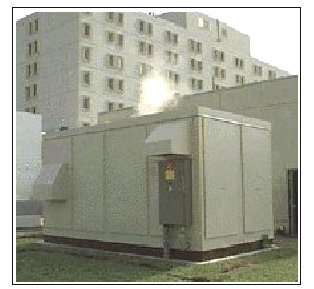The Natural Gas Fuel Cell
(NGFC) is an emerging technology that uses an electrochemical process to
generate electrical power using natural gas (or other fuel) as the fuel
Fuel cells can provide high quality power for a
variety of uses. The fuel cell technology can save energy and power
generation costs due to the high efficiency of the electrochemical process
and by using low cost natural gas. Additionally, savings are generated by
the production of supplemental heat, available in the form of hot water
that can be applied to other industrial applications.
The U.S. Department of Defense (DoD) initiated the
Fuel Cell Demonstration Program (FCDP) to determine the viability of the
use of the natural gas fuel cell technology (particularly PAFCs) for DoD
facilities and applications, as well as the role of fuel cells in the
DoD's long-term energy strategy. The U.S. Army Construction Engineering
Research Laboratory (USACERL) was assigned the mission of managing the
FCDP for the DoD. The program's goal was to develop the criteria necessary
to evaluate the technology along with developing and implementing PAFC
packages for DoD demonstration sites. Since 1993, DoD has appropriated
$36.75 million dollars to the program.
Since 1995, under the FCPD, DoD has installed 30
stationary 200-kilowatt fuel cells at bases around the country. Heat from
the fuel cells is used for boilers, domestic hot water, space heating, and
process hot water. As of January 1999, the 30 fuel cells had saved a
combined total of $2,704,711 in energy costs and abated 16,094 tons of
carbon dioxide (CO2), 280 tons of sulfur oxides (SOx), 129 tons of
nitrogen oxides (NOx) and 11 tons of carbon monoxide (CO).
The technology can be used wherever electrical power
is required. Examples of sites and applications included under the DoD
FCDP program include;
- Hospitals MCB Camp Pendleton, CA
- Central heating plants NETC Newport, RI
- Galleys NAS Fallon, NV
- Dormitories USNA Annapolis, MD
- Administration facilities NAVO Stennis Space
Center, MS
- Swimming pools NCBC Port Hueneme, CA
CERL maintains a web site that contains a wealth of
detailed information on fuel cell technology, the FCDP, the DoD
installations, and many other resources for information on fuel cell
technology and its implementation. This is the most comprehensive resource
for information for DoD facilities interested in implementing fuel cell
technology.
Although the fuel cell provides many advantages over
combustion based power generation, the main barrier to widespread use is
their cost. Although commercially available, PAFCs are still very
expensive and the potential savings is dependent on many site- specific
factors.
There are two programs currently in place that provide
vehicles to potentially offset some of the costs associated with
implementation of fuel cell technology. The Climate Change Fuel Cell
Program is a DoD-funded program that provides grants to nonfederal
agencies and organizations to install fuel cells. These grants can be used
to offset some of the cost for implementation of the technology, thus
giving facilities additional incentive to pursue this alternative.
The Air Emissions Reduction Credit Program allows DoD
facilities to earn revenue from the sale or lease of air emission credits
generated by reduction of air emissions below allowable levels. The
revenue generated can be used for environmental programs, including the
cost of implementing an emission reducing technology.

